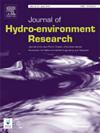Impacts on fish transported in tube fishways
Abstract
Experimental data and numerical predictions of steady and unsteady flow in a 4 m high, 86 mm internal diameter tube fishway were compared quantitatively, and reflected expected uncertainties characteristic of the experiments and flow hydraulics. We then measured the response of a neutrally-buoyant fluid sensor and the behaviour of live fish transported vertically within the tube fishway. Ten repeat tests using the sensor and tests with seventy individual live fish demonstrated transport with 100% reliability. No ill effects were observed over a post-test monitoring period for two species of Australian native fish (Australian bass (Percalates novemaculeata) and Silver perch (Bidyanus bidyanus)) or as a function of size of the Silver perch that can be related to their passage through the fishway. There may have been temporary bruising of a few of the largest Silver perch tested. The largest Silver perch averaged 137 mm in length. The spatial distributions of the inert sensor and fish relative to the moving front during the transport process were quantified. Consequently, the volumes of water required during each operational cycle to ensure reliable delivery of fish over vertical distances less than 4 m were determined. The sensor measurements indicated negligible interactions with straight pipe walls but exposure to significant accelerations at sharp bends. Further experiments with live fish are required to quantify the possible adverse effects of alternative pipe transition designs on animals transported through them. Safe transport of fish up to a fish length/tube fishway delivery diameter ratio of 1.6 is demonstrated.

 求助内容:
求助内容: 应助结果提醒方式:
应助结果提醒方式:


